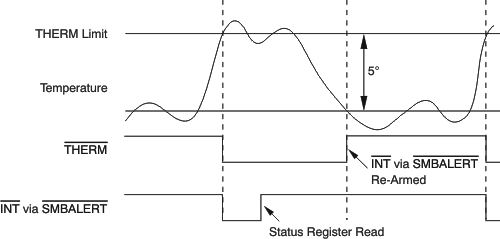ZHCSR80A June 2009 – January 2023 AMC6821-Q1
PRODUCTION DATA
- 1 特性
- 2 應(yīng)用
- 3 說(shuō)明
- 4 Revision History
- 5 說(shuō)明(續(xù))
- 6 Pin Configuration and Functions
- 7 Specifications
-
8 Detailed Description
- 8.1 Functional Block Diagram
- 8.2 Feature Description
- 8.3 Device Functional Modes
- 8.4 Programming
- 8.5 Register Map
- 9 Application and Implementation
- 10Device and Documentation Support
- 11Mechanical, Packaging, and Orderable Information
封裝選項(xiàng)
機(jī)械數(shù)據(jù) (封裝 | 引腳)
- DBQ|16
散熱焊盤(pán)機(jī)械數(shù)據(jù) (封裝 | 引腳)
訂購(gòu)信息
8.2.8.1.1 THERM Pin as an Output
As an open-drain output, the THERM pin is the indicator of temperature over the THERM limit. When the remote temperature exceeds the Remote-THERM-Limit, or when the local temperature is greater than the Local-THERM-Limit, the THERM pin goes low and remains low until the measured temperature falls 5°C below the exceeded THERM limit.
 Figure 8-12 Structure
of the THERM Pin
Figure 8-12 Structure
of the THERM PinWhen the THERM limit is exceeded, the corresponding status flag bit (R-THERM or L-THERM of Status Register 1 or Status Register 2) is set to '1', and the THERM interrupt through the SMBALERT pin is generated if it is enabled (THERMOVIE of bit Configuration Register 1 is set to '1'). This interrupt forces the SMBALERT pin low. Note that the THERM pin is always forced to low when R-THERM = 1 or L-THERM = 1, no matter what the status of THERMOVIE is. Reading the status registers clears the flag bit (R-THERM and L-THERM). Clearing the flag bit makes the SMBALERT pin go back to high, but does not negate the THERM pin. It remains low until the temperature falls 5?C below the exceeded THERM limit. After this bit is cleared, the active flag bit (R-THERM for remote temperature or L-THERM for local temperature) and the THERM interrupt are not re-armed until the temperature falls 5°C below the exceeded THERM limit. Figure 8-13 shows this procedure.
 Figure 8-13 Operation
of the Therm Interrupt and the THERM Pin
Figure 8-13 Operation
of the Therm Interrupt and the THERM PinWhen working as an output, the status of the THERM pin affects the RPM fan. If the THERM-FAN-EN bit is set ('1'), the fan goes to full-speed (that is, the duty cycle is 100%) when the THERM pin goes low. However, when THERM-FAN-EN = 0, the status of the THERM pin does not affect the fan speed.